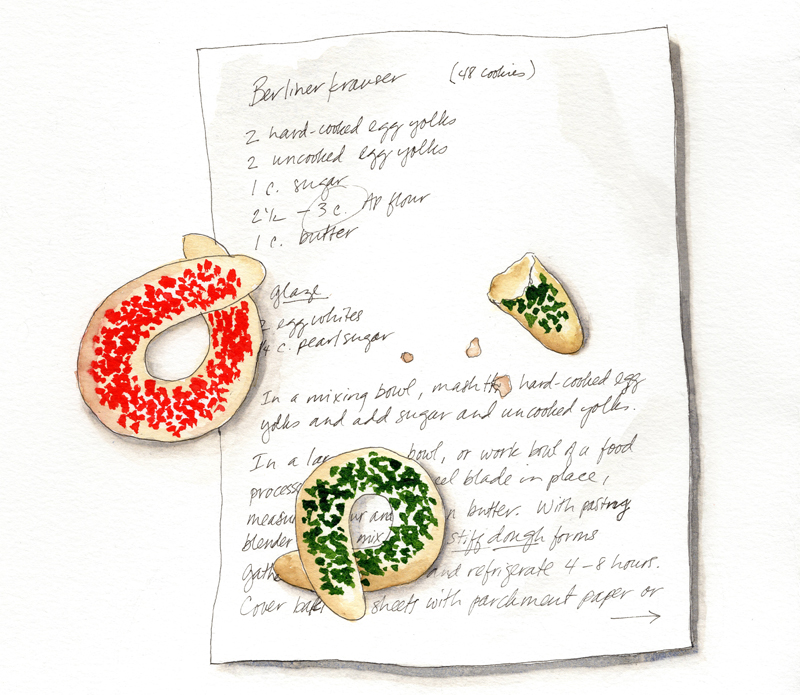ILLUSTRATED BY TERRI WENTZKA
Festive Recipes is a six-part series of home kitchen methods designed to take the edge off of a brutal year. It was conceived by Amy Rea, and illustrated by Terri Wentzka. You can find the first two recipes at heavytable.com; the remaining four will be published in the Dec. 18 edition of the Heavy Table’s newsletter, available via Patreon.
My grandmother was a Norwegian immigrant who would sing Christmas carols in Norwegian and drop Norwegian phrases into her speech. She also, every Christmas Eve, set a dinner table that included such classics as lefse and krumkake, as well as lutefisk for the few who would eat it. (As a most excellent grandmother, she never once tried to force her grandkids to eat it. Thank you, Grandma.)
Cut to the present day, Grandma long gone, and me being someone who loves to cook, but hates to bake. The gene that allows people to efficiently and effectively roll out doughs of any kind, whether by hand or with a rolling pin, apparently skipped right over me and landed in both of my sons, so lefse is present at our holiday gatherings. Also? Baking is usually too precise. I like a more relaxed attitude toward amounts and ingredients. Nevertheless, I bought Beatrice Ojakangas’ Great Scandinavian Baking Book and a krumkake iron, and learned that krumkake is not difficult and even kind of fun. (In other words, for me, not real baking.)
But there was one other thing Grandma used to make, only at Christmas: Berlinerkranser. These are little buttery cookies, eggy and rich, with a festive coating of brightly colored sugar. Grandma, of course, made it look easy: She deftly rolled out thin ropes of dough, then looped them around to make little wreaths before dipping them in egg wash and coating them with colored sugar. In the oven, her Berlinerkranser puffed up like little pillows, plump and smelling heavenly.
I decided several years ago that I’d like to make Berlinerkranser, my lack of baking expertise and interest be damned. I wanted those long-ago cookies that have come to represent Christmas Eve to me to appear on my own family’s table. Back to Beatrice Ojakangas I went.
But there was a problem. As good as the cookies tasted—exactly like I remembered—they would not roll into thick ropes and then into plump wreaths. Time and again I tried. They cracked apart, didn’t plump out, certainly didn’t look like a wreath. More than one Christmas Eve found the whole family gathered around the kitchen table, trying to work Grandma’s magic, and failing miserably. (It’s entirely possible that the annual Christmas cranberry slush had a roll in this failure.)
Last year, a decades-long friend and I decided to spend a day making Christmas cookies together. She’s a much more accomplished baker than I am. My role was largely cheerleader and measuring out ingredients. I’d told her about Berlinerkranser, and she was intrigued. She looked at the recipe and asked how much flour I’d used. Ojakangas calls for 2 ½-3 cups of flour. I’d always used 2 ½, and thought that the way the dough cracked and broke was from too much flour. No, said the friend. Probably not enough. She made the dough with 3 cups.
Guess what?
Berlinerkranser. Real, plump, flexible dough rings that made the kitchen smell heavenly and brought back to many memories. And now it has new memories attached to it—having a friend solve your baking block and find a way to reclaim that childhood memory is, as they say, priceless.
We’d planned to make cookies together again this year, but COVID made other plans for us. I’ll try the Berlinerkranser on my own. But my friend loved the cookies so much that she’s adding them to her regular holiday baking menu and promised she’d share hers if mine don’t turn out.
Berlinerkranser (Norwegian Berlin Rings)
Adapted from Beatrice Ojakangas’ The Great Scandinavian Baking Book
Makes 48 cookies
2 hard-cooked egg yolks
2 uncooked egg yolks
1 cup sugar
2 ½-3 cups all-purpose flour (2 ½ didn’t work for me, but 3 did)
1 cup butter
Glaze:
2 egg whites
¼ cup pearl sugar or crushed sugar cubes, or other cookie decoration
In a mixing bowl, mash the hard-cooked yolks with the uncooked yolks and add the sugar.
In a large mixing bowl, or in the work bowl of a food processor with the steel blade in place, measure the flour and slice in the butter. With pastry blender or fork, mix until butter is cut into the flour, or using on/off pulses of the food processor process until mixture is crumbly. Add the egg yolk mixture and mix until a stiff dough forms.
Gather dough into a ball and refrigerate 4-8 hours.
Cover baking sheets with parchment paper or lightly grease them. Preheat oven to 350F.
Working a part of the dough at a time, roll between palms of hands and lightly floured board into roles ½-inch thick. Cut into 3-inch sections and turn into little wreaths, pinching ends together. Dip into unbeaten egg white and then into sugar. Place on prepared baking sheets. Bake for 10-12 minutes or until lightly browned.

